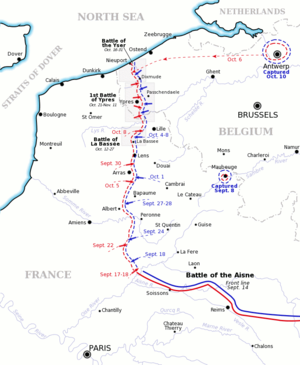Battle of the Yser - No Picture
More about World War 1
|
|
Battle of the Yser
Date
16 October - 31 October 1914
Location
River Yser, Belgium
Result
Franco-Belgian victory
Date: 16 October - 31 October 1914
Location: River Yser, Belgium
Result: Franco-Belgian victory
Belligerents:
: Belgium
France
Commanders and leaders:
: Albert I of Belgium
Strength:
: Belgium: 4 infantry divisions, 2 reserve divisions
France: 1 infantry division, 2 Marine regiments
Casualties and losses:
: Belgium: 40,000
France: 15,000
The Battle of the Yser secured part of the coastline of Belgium for the allies in the "Race to the Sea" after the first three months of World War I.
Strategic Context
As part of the execution of the Schlieffen Plan, Belgium had been invaded by Germany. Following the Siege of Antwerp, the remnants of the Belgian Army were pushed back to the far south west corner of the country, and decided to make a stand behind a 22-mile long front on the Yser Canal as the Germans tried to reach the French Channel ports of Calais and Dunkerque. Just to the south the First Battle of Ypres took place at the same time as the Battle of the Yser and both battles concluded a series of unsuccessful flanking manoeuvres by the belligerents and established the trench lines of the Western front.
Battle of the Yser
The entire Belgian Army was deployed to defend the front. The troops were exhausted and low on ammunition after two months of retreating throughout almost the entire Belgian territory. France reinforced the Belgians with 6,000 Marines and an infantry division.
The first skirmishes started on 16 October 1914. The town of Diksmuide was attacked but the Germans were repelled by French marines and Belgian artillery. The following day German troops (consisting of trained conscripts, reservists and partially trained students) moved southwards from Bruges and Ostend in the direction of the Yser river. It became clear that the German Fourth Army was to take the line from Nieuwpoort to Ypres.
Admiral Hood of the Royal Navy commanded three monitors, Severn, Humber and Mersey, which bombarded the German army in Lombardsijde from the sea the following day.
On 18 October the German offensive started. It initially overran the frontal defense positions of the Belgian, British and French armies along a line stretching from Nieuwpoort down to Arras in France. The objective was to defeat the Belgian and French armies and to deprive the British of access to the harbours of Calais, Boulogne and Dunkerque.
It took four days of heavy fighting for the German troops to drive the allies back and reach the borders of the river Yser. On 21 October, the Germans were able to establish a small bridgehead on the other side of the river. The last bridge over the Yser was blown up on 23 October. Diksmuide bore the brunt of repeated German offensives and bombardments yet the town was still not taken.

Picture - Course of the "Race to the Sea" showing dates of encounters and highlighting the significant battles.
The French high command planned to inundate large parts of their territory with water as a defensive measure. This would have put the Belgian army in the impossible choice of being trapped between the inundations and the German forces or abandoning the last part of unoccupied Belgium. The plan was postponed since the Belgian army itself had started preparations to inundate the area between the river Yser and its tributary canals.
On 25 October the German pressure on the Belgian army had grown so large that a decision was taken to inundate the entire Belgian front line. After an earlier failed experiment on 21 October, the Belgians managed to open the sluices at Nieuwpoort during the nights of 26 October to 29 October during successive high tides, thereby steadily raising the water level until an impassable flooded marshland was created up to a mile wide and stretching as far south as Diksmuide. Karel Cogge and Hendrik Geeraerts became (Belgian) national heroes for their decisive role in the inundations. On 29 October Diksmuide finally fell into German hands. The Germans had planned another decisive attack for 30 October. The attack punched through the Belgian second line but stalled after Belgian and French counterattacks from the front and the flooding from the rear. This final attack was called off and the front stabilized.
Importance
The historical importance of the Battle of the Yser is twofold. First, Germany did not manage to defeat the Belgian army and knock Belgium out of the war. Second, the German failure to occupy the last corner of Belgium helped to conclude the Race to the Sea and contributed to the establishment of the Western front.
The struggle of the Belgian army to hold on to its territory during the remainder of the war, and especially the experiences of ordinary Flemish foot soldiers, led to an increased Flemish national consciousness in the then overwhelmingly Francophone-dominated Belgian society.
Commemorative Medal (Front)
Commemorative Medal (Obverse)
Commemorative medal
More aircraft.
Source: WikiPedia